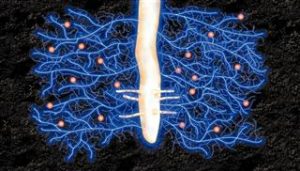Vesicular Arbuscular mycorrhizae
Vesicular Arbuscular mycorrhizae are a category of fungus the penetrate the cortical cells of the roots of a vascular plant. These mycorrhiza are characterized by the formation of unique structures, arbuscules and vesicles by fungi of the phylum Glomeromycota. The fungi help plants to capture nutrients such as phosphorus, sulfur, nitrogen, and micronutrients.
VA mycorrhiza form associations with plants in the Angiosperm, Gymnosperm, and Pteridophyte categories.
VA mycorrhiza have three main components
The root
The fungal structures within the cells of the root
The Extraradical mycelium in the soil
Members of the mycorrhiza family are common soil fungi and spores or sporocarps can be collected from almost any soil. Long term compatible interactions are based on bidirectional nutrient transfer between the symbiotic plants and fungi. Some species form sporocarps with limited amounts of sterile mycelium
Classification of VA mycorrhizal fungi are based on the structure and development of the walls of the spores. Taxonomic descriptions and classifications are based on Murographs.
Characteristics of the vegetative stages, such as form of the entry points and branching of hyphae within the root, are variable between fungal species and can be used for recognition purposes by experienced observers.
VA mycorrhizal fungus isolated from one species of host plant will colonize any other species that has been shown to be capable of forming VA mycorrhizae, thus combining wide host range with permanence of association.
Mycorrhizal colonization of roots can be blocked at a number of stages in typical host plants, failure of colonization in non-mycorrhizal plants are due to a number of different mechanisms.
VA mycorrhizal are more frequent on plants growing on mineral soils
Ectomycorrhizas and some cricoid mycorrhizal are characteristic of plants growing on soils with relatively large deposits of organic matter.
High occurrence of VA mycorrhizal in plant communities with high species diversity.
Low incidence of Vesicular Arbuscular mycorrhiza occurs in extreme environments, such as very moist or arid areas, highly disturbed soils, very nutrient rich soils, or tundra and high alpine habitats.
The lack of specificity means that a single plant species can be colonized by many different fungi and individual plants can be linked below ground by common mycorrhizal mycelium
Spores, Root fragments and hyphae are the propagules that can initiate VA mycorrhizal colonization.
Hyphae form a complex network which link plants of the same and different species. The networks are able to survive both dry and cold conditions, which helps the colonization of roots early in the following season.
Outside the root, an extensive mycelium develops and appears to undergo differentiation, so that different types of hyphae perform different functions in colonization, nutrient acquisition, and survival.
The development of mycorrhizas are under the control of plant and fungal genes, which act in a coordinated manner to produce the characteristic, biotrophic and compatible interaction in mycorrhizal host species.
In low input agriculture where high efficiency of nutrient uptake is required, a cultivar that is both highly susceptible and highly responsive to mycorrhizas would be appropriate.
In highly fertilized situations a non-susceptible and non-responsive cultivar might be more suitable, assuming that mycorrhizal effects on interactions with pathogens or soil structural stability has been adequately considered.
VA mycorrhizal fungi are dependent on an organic C supply from a photosynthetic partner. Between 4-20% of net photosynthate is transferred to the fungus and used in production of both vegetative and reproductive structures, and in respiration to support growth and maintenance, including nutrient uptake.
Glucose can be absorbed by the fungus and transfer from plant to fungus occur across the interface between intercellular hyphae and cortical cells of the root.
External hyphae of VA mycorrhizal fungi absorb non-mobile nutrients from soil and translocate them rapidly to the plants, overcoming problems of depletion in the rhizosphere. Transfer across the symbiotic interface results in increased nutrient acquisition by the plant.
Hyphae are able to penetrate soil pores inaccessible to roots and may also be able to compete effectively with soil-inhabiting microorganisms for recently mineralized nutrients.
